b. State Key Laboratory of Systematic and Evolutionary Botany, Institute of Botany, Chinese Academy of Sciences, Beijing, 100093, China;
c. University of Chinese Academy of Sciences, Beijing 100864, China;
d. National Herbarium and Plant Laboratories, Godawari, Lalitpur, Nepal;
e. CAS Key Laboratory for Plant Biodiversity and Biogeography of East Asia, Kunming Institute of Botany, Chinese Academy of Sciences, Kunming, Yunnan 650201, China;
f. Forestry and Grassland Bureau of Pu'er, Chacheng Avenue 48, Pu'er, Yunnan 665000, China;
g. Wenshan National Nature Reserve Administration, Wenshan, Yunnan 663000, China;
h. Yunnan Forestry Technological College, Jindian Road, Kunming, Yunnan 650000, China;
i. Sichuan Wujiao Nature Reserve, Jiuzhaigou, Aba, Sichuan 623400, China;
j. Yunnan Laboratory for Conservation of Rare, Endangered & Endemic Forest Plants, Public Key Laboratory of the National Forestry and Grassland Administration, Yunnan Academy of Forestry and Grassland, Kunming, Yunnan 650201, China
During botanical surveys in Southwest China from 2017 to 2020, we collected a great number of orchid species. After comparing the morphological features of collected specimens with those of herbarium specimens (i.e., taxa similar to Cheirostylis Blume , Myrmechis Blume and Bulbophyllum Thouars) and consulting relevant literature (for Cheirostylis, see Hemsley, 1895; Rolfe, 1896, 1903; Seidenfaden, 1978; Jin et al., 2007a, b; Chen et al., 2009; Liu et al., 2016b; Wu et al., 2020; for Myrmechis, see Rolfe, 1903; Seidenfaden, 1978; Maity et al., 2007; for Bulbophyllum, see Summerhayes, 1928; Seidenfaden, 1969, 1979; Lin, 1975; Tsi, 1989; Chen et al., 2009; Raskoti and Ale, 2011; Vermeulen et al., 2015; Averyanov et al., 2015, 2018, 2019; Liu et al., 2017; Zhai et al., 2017; Li et al., 2019; Ya et al., 2019a; Ma et al., 2020), we confirmed that eight species are new to science and three species are new records for China. Here, these species are described and illustrated
2. Materials and methodsLiving plants and herbarium vouchers were collected from Yunnan, Sichuan and Xizang in Southwest China. The morphological characters and measurements of the species described here were based on living materials in the field and greenhouse, as well as dried specimens. The delicate structure of the lip, column and pollinia were observed, measured and photographed under the dissecting stereomicroscope (Olympus SZX16 and MD-90). Voucher specimens have been deposited in the Herbarium of the Kunming Institute of Botany, Chinese Academy of Sciences (KUN), Chinese National Herbarium (PE) and Herbarium of the Yunnan Academy of Forestry and Grassland (YAF).
3. Results 3.1. Goodyerinae KlotzschCheirostylis and Myrmechis are two small genera in Goodyerinae which comprise 34 genera (Pridgeon et al., 2003). The two genera are similar in having connate sepals and separate stigma lobes, but Cheirostylis differs from Myrmechis by having a lip with two or more lobed or seriate papillose calli, stigma lobes that are not free apically and a column with two extended stelids, and without wings (Pridgeon et al., 2003; Chen et al., 2009). Recent molecular phylogenetic studies showed that Cheirostylis is monophyletic, but the relationships with closely related genera remain unresolved (Chen et al., 2019). Previous studies have proposed including Myrmechis into a broadly circumscribed Odontochilus Blume as Myrmechis and Kuhlhasseltia J.J. Smith are nested within it (Yukawa, 2016; Chen et al., 2019); however the relationships of Goodyerinae have not been resolved completely and require broader sampling. Here we follow the traditional delimitation of Cheirostylis and Myrmechis (Pridgeon et al., 2003). Cheirostylis includes 55 species widespread from tropical and Southern Africa through India, Southeast Asia, to the West Pacific islands; eighteen species are recorded in China (Pridgeon et al., 2003; Chen et al., 2009; POWO, 2021). Myrmechis is mainly distributed in tropical and subtropical Asia to the Kuril Islands; there are 12 accepted species and five of them are found in China (Pridgeon et al., 2003; Chen et al., 2009; POWO, 2021).
3.1.1. Cheirostylis chuxiongensis J.D. Ya, sp. nov. (小唇叉柱兰) (Fig. 1)
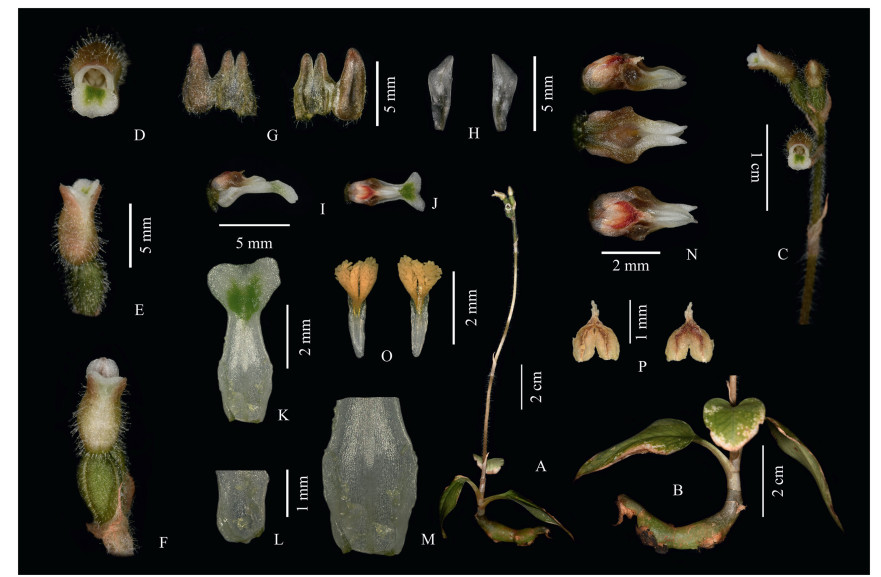
|
| Fig. 1 Cheirostylis chuxiongensis J.D. Ya, sp. nov. A. Plant; B. Rhizome; C. Inflorescence; D. Flower (front view); E. Flower (lateral view); F. Flower (dorsal view); G. Sepals; H. Petals; I & J. Column and labellum; K. Labellum; L & M. Calli; N. Column; O. Pollinarium; P. Anther cap. (Photographed by J.-D. Ya). |
Diagnosis: Cheirostylis chuxiongensis is similar to C. thailandica Seidenf. in floral morphology, but differs from the latter by having 5–9 irregular and papillae-like calli on each side in the sac of the lip (vs. 2 comb-like calli), epichile with entire lobes (vs. lobes apical irregularly denticulate to wavy), petals narrowly obliquely obovate and an apex that is not recurved (vs. suboblong and apex recurved).
Type: CHINA. Yunnan: Kunming, voucher from cultivated plants at Kunming Institute of Botany, CAS, 15 Mar. 2020 (flowering), J.-D. Ya, L. Huang & R.-Z. Zhang 19HT3275 (holotype: KUN!), originally collected in Yunnan Province, Chuxiong Prefecture, Shuangbai County, 1060 m, a valley in coniferous forest.
Plants 7.0–17.0 cm tall. Rhizome moniliform, 3.0–4.0 cm long, with 3–5 nodes; internodes narrowing, 0.5–1.2 cm in diam.; roots in broad, raised bands along rhizome internodes. Stem pale green, usually less than 1 cm tall, usually 3-leaved. Leaves congested, ovate to oblong-ovate, 1.8–3.6 × 1.4–2.4 cm, often absent or withered at anthesis, green, membranous, base subrounded, apex acute; petiole-like base and sheath 0.4–0.5 cm long. Inflorescence 8.0–14.0 cm long, sparsely villous, with 2 sterile bracts; rachis 0.3–0.5 cm, 2–3-flowered; floral bracts ovate, concave, 4.0–5.0 mm long, shorter than ovary, abaxially villous, apex acuminate. Flowers yellowish-green, petals white, lip white with two green spots at the epichile base; ovary and pedicel pubescent, ca. 4.0–8.0 mm long. Sepals 5.0–6.0 mm long, basal connate for 1/2 and forming a tube, membranous, outer surface sparsely villous, 1-veined; free apical lobes 2.5–3.0 mm long, dorsal lobe triangular-ovate, lateral lobes obliquely triangular-ovate, apex subobtuse. Petals appressed to dorsal sepal, narrowly obliquely obovate, ca. 5.0–5.5 × 1.3–1.5 mm, membranous, 1-veined, entire, apex acute; lip erect, 5.5–6.0 mm long, slightly 3-partite; hypochile saccate, with scattered 5–9 irregularly and papillary calli on each side; mesochile ca. 1.7 × 1.3 mm, margin slightly involute; epichile flabellate, 2.5–3.0 × 1.7–2.0 mm, entire or shallowly bilobed, apical margin entire. Column ca. 3.5 mm long; rostellum arms elongate, ca. 1.8 mm long; stelidia erect, slightly longer than rostellum arms; pollinarium ca. 3.0 mm long; anther ovoid, ca. 1.7 mm long; viscidium cuneiform, ca. 2.2 × 0.6 mm.
Phenology: Flowers from March to April.
Etymology: The epithet "chuxiongensis" is derived from the type locality of the new species, Chuxiong, Yunnan, China.
Distribution and habitat: Cheirostylis chuxiongensis is only known from Shuangbai County, Central Yunnan. The population consists of ca. 200 scattered individuals in a valley in coniferous forest dominated by Pinus yunnanensis Franch. at elevations of 1000–1100 m.
3.1.2. Cheirostylis yei J.D. Ya, Z.D. Han & H. Jiang, sp. nov. (叶氏叉柱兰) (Fig. 2)
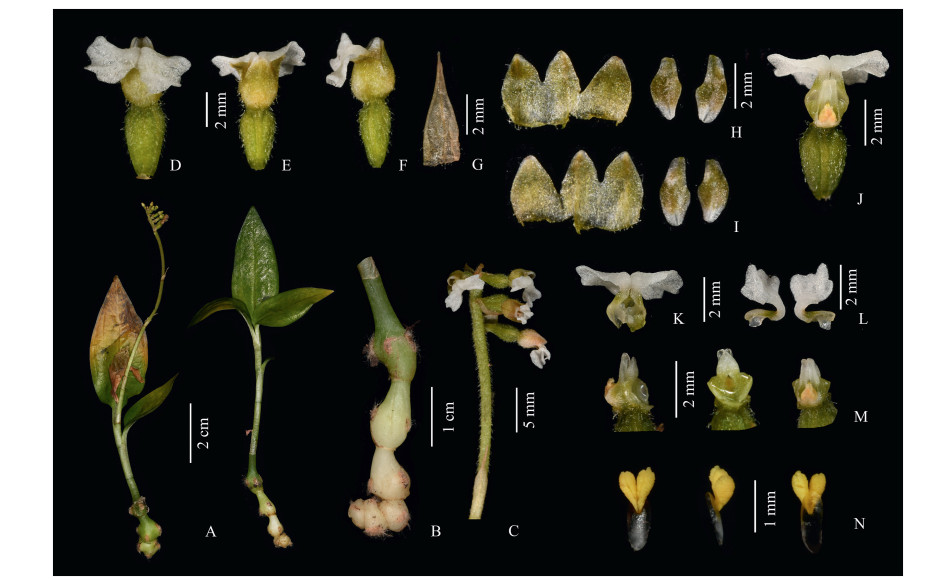
|
| Fig. 2 Cheirostylis yei J.D. Ya, Z.D. Han & H. Jiang, sp. nov. A. Plant; B. Rhizome; C. Inflorescence; D. Flower (front view); E. Flower (dorsal view); F. Flower (lateral view); G. Bract; H. Adaxial sepals and petals; I. Abaxial sepals and petals; J. Column and labellum; K. Labellum; L. Labellum (rip cutting); M. Column; N. Pollinarium. (Photographed by J.-D. Ya). |
Diagnosis: Cheirostylis yei is similar to C. chinensis Rolfe, C. yunnanensis Rolfe and C. moniliformis (Griff.) Seidenf. in floral morphology. The new species can be distinguished from C. chinensis by having epichile lobes with irregular, undulate margins (vs. 4- or 5-dentate, teeth triangular and acute), a subquadrate callus without teeth (vs. calli comb-like with 5- or 6-toothed), and oval viscidium (vs. narrowly oblong). It can be distinguished from C. yunnanensis by having a long 3.8–7.2 cm stem (vs. usually less than 1 cm), smaller flowers with a 4.5 mm long lip (vs. 9–12 mm long), and a subquadrate callus without teeth in the saccate hypochile (vs. calli comb-like with 3- or 4-toothed). The new species can be distinguished from C. moniliformis by having pubescent ovary and sepals (vs. glabrous), a subquadrate callus in the saccate hypochile (vs. 2–4 papillae-like calli), and long elliptic stelidia (vs. falcate- or linear-lanceolate).
Type: CHINA. Yunnan: Kunming, voucher from cultivated plants at Kunming Institute of Botany, CAS, 15 Nov. 2019 (flowering), J.-D. Ya & Z.-D. Han 19HT3124 (holotype: KUN!), originally collected in Yunnan Province, Pu'er City, Simao District, Liushun Town, 1870 m, in forest on limestone.
Lithophytic herbs, 10.0–17.0 cm tall. Rhizome almost vertical, white to green, 3.0–4.0 cm long, with 3–5 nodes, torose to moniliform, internodes distinctly narrowing towards the nodes, 0.8–1.2 cm in diam.; roots hair-like, in rows along rhizome internodes. Stem erect, 3.8–7.2 cm long, 2–5 leaved apically. Leaves congested, often withered at anthesis, ovate to ovate-lanceolate, 1.7–6.5 × 0.8–2.8 cm, glabrous, base cuneate, apex acute; petiole-like base and sheath 1.8–2.5 cm long. Inflorescence 8.0–12.0 cm long, hairy, with 2 or 3 sterile bracts; rachis short, ca. 1 cm long, 4–7-flowered; floral bracts ovate-lanceolate, 0.6–0.8 cm long, nearly as long as ovary, abaxially hairy, apex long acuminate. Flowers yellowish-green, lip lobes white; ovary and pedicel pubescent, ca. 4.0 mm long; sepals 3.0 mm long, basal about 1/2 connate and forming a tube, outer surface sparsely pubescent, free apical lobes triangular-ovate, ca. 1.2 mm long; petals appressed to dorsal sepal, obliquely oval, 2.8 × 1.5 mm; lip 4.5 mm long, 3-partite; hypochile saccate, ca. 1.5 mm long, each part with 1 callus, calli subquadrate, ca. 0.7 × 0.7 mm; mesochile ca. 1.0 mm long, narrow; epichile flabellate, ca. 3.0 mm long, deeply 2-lobed; lobes ca. 2.0 mm wide, margin irregularly undulate; column ca. 2.0 mm; rostellum arms elongate, ca. 1.0 mm long; stelidia erect, long elliptic, slightly shorter than rostellum arms; pollinarium ca. 1.5 mm long; anther ovoid, ca. 0.8 mm; viscidium oval, ca. 1.1 mm long. Fruit not seen.
Phenology: Flowering from October to November.
Etymology: The specific epithet "yei" is in honor of Mr. De-Ping Ye (1977–2020), who dedicated over twenty years to the botanical surveys and conservation of wild orchids in China. Sadly, he died in an accident; his death is a great loss to orchid research and conservation in China.
Distribution and habitat: Cheirostylis yei is currently known from south and southwest Yunnan. It is a predominantly lithophytic species that grows on rocks in karst regions at elevations of 1470–1900 m.
Additional specimen examined (paratypes): CHINA. Yunnan: Lincang Prefecture, Zhenkang County, Muchang Town, 1470 m, in forest on limestone, 17 Oct. 2020, H. Jiang 10118 (YAF).
Notes: Cheirostylis chinensis and C. yunnanensis share highly similar morphology, and both species display wide variation in lips in overlapping distributions in China, Myanmar and Vietnam. Further research is required to investigate the species delimitation in Cheirostylis. In this study, therefore, we tentatively adopt the traditional circumscription of Cheirostylis according to the treatments in Flora of China and Flora of Thailand (Chen et al., 2009; Pedersen et al., 2011).
3.1.3. Myrmechis lingulata J.D. Ya, Ting Zhang & C. Liu, sp. nov. (九寨沟全唇兰) (Figs. 3 and 4)
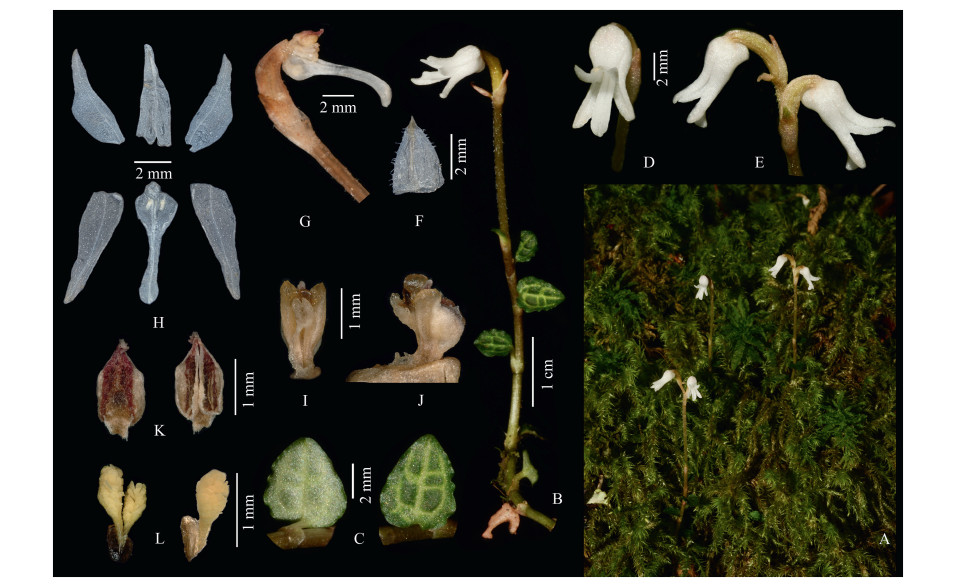
|
| Fig. 3 Myrmechis lingulata J.D. Ya, Ting Zhang & C. Liu, sp. nov. A. Habit; B. Plant; C. Leaf; D. Flower; E. Inflorescence; F. Bract; G. Column and lip; H. Sepals, petals and lip; I & J. Column; K. Anther cap; L. Pollinarium. (Photographed by J.-D. Ya & C. Liu). |

|
| Fig. 4 Myrmechis lingulata J.D. Ya, Ting Zhang & C. Liu, sp. nov. A. Plant; B. Stem; C. Villous of inflorescence; D. Leaf; E. Flower (lateral view); F. Flower (front view); G. Bract; H. Petals; I. Dorsal sepal; J. Lateral sepal; K. Column and lip; L. Lip; M. Column; N. Anther cap; O. Pollinarium. (Drawn by Rong-Mei Zhang). |
Diagnosis: Myrmechis lingulata is similar to M. chinensis Rolfe in floral morphology, but differs by having a simple and lanceolate to ligulate lip (vs. lip T-shaped), glabrous bracts and ovary (vs. sparsely villous), oblique and narrowly ovate petals (vs. ovate, not oblique).
Type: CHINA. Sichuan: Aba Prefecture, Jiuzhaigou County, Wujiao Town, under Picea forest, 2508 m, 15 July 2019, Ting Zhang et al. 19CS18360 (holotype: KUN!; isotype: KUN!).
Terrestrial herb, 6–8 cm tall. Rhizome creeping. Stem slender, ca. 1.0 mm in diam., with several leaves. Leaves widely spaced along stem, orbicular to ovate, 4.5–6.5 × 3.5–6.5 mm, base obtuse-rounded, apex obtuse or acute; petiole-like base and sheath ca. 1.8–3.0 mm long; nerves yellowish-green and raised adaxially. Inflorescence 2.0–3.5 cm long, sparsely villous; rachis 1–2-flowered; floral bracts ovate, ca. 2.6 × 2.1 mm, glabrous, margin ciliate, apex acute or acuminate. Flowers not opening widely, white; ovary and pedicel 5.0–8.0 mm long, glabrous. Sepals 1-veined, connate at base, apex acuminate, glabrous; dorsal sepal ovate-lanceolate, 5.5–6.5 × 1.8–2.0 mm; lateral sepals obliquely ovate-lanceolate, ca. 7.6 × 2.2 mm; petals narrowly ovate, oblique, ca. 6.5 × 2.1 mm, connivent with dorsal sepal and forming a hood, apex acuminate; lip simple, lanceolate to ligulate, ca. 7.0 × 1.2 mm, entire, apex obtuse; hypochile concave-saccate, calli oblong; column short, ca. 1.7 mm; pollinarium ca. 1.5 mm long; anther ovoid, ca. 1.0 mm long; viscidium brown, oval, ca. 0.8 mm long.
Phenology: The new species was observed in flowering in July.
Etymology: The specific epithet "lingulata", meaning "the shape of a strap", refers to the simple and lanceolate to ligulate lip of this new species.
Distribution and habitat: M. lingulata is currently known only from the type locality of Wujiao Town. It grows on mossy places under Picea forests at an elevation of about 2500 m.
3.1.4. Myrmechis longii J.D. Ya, sp. nov. (美脉全唇兰) (Fig. 5)
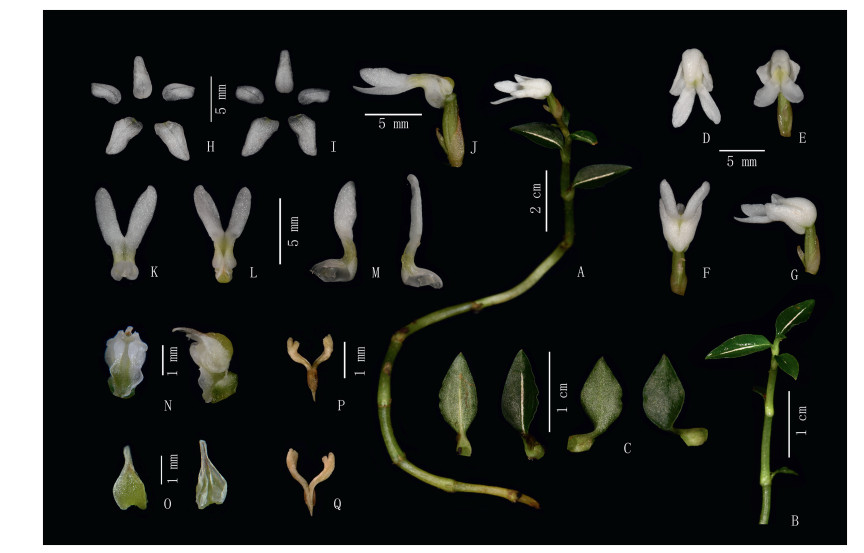
|
| Fig. 5 Myrmechis longii J.D. Ya, sp. nov. A & B. Plant; C. Leaf; D & E. Flower (front view); F. Flower (dorsal view); G. Flower (lateral view); H. Adaxial sepals and petals; I. Abaxial sepals and petals; J. Column and lip; K. Abaxial lip; L. Adaxial lip; M. Lip (rip cutting); N. Column; O. Anther cap; P. Pollinarium (front view); Q. Pollinarium (dorsal view). (Photographed by J.-D. Ya). |
Diagnosis: Myrmechis longii is similar to Myrmechis pumila (Hook. f.) Tang & F.T. Wang in floral morphology, but differs by having white-veined leaves (vs. green-veins), oblong-lanceolate epichile lobes 4.0–4.2 mm long (vs. oblong and diverging widely, 2–3 mm long), and viscidium attached to the middle of the caudicle (vs. viscidium attached to the base of the caudicle).
Type: CHINA. Yunnan: Wenshan Prefecture, Malipo County, 1500 m, in forest on limestone, 21 July 2020, J.-D. Ya, M.-F. Long, M.-J. Feng & M.-Q. Han 20CS19132 (holotype: KUN!; isotype: KUN!).
Terrestrial herb, 5–10 cm tall. Rhizome creeping. Stem slender, ca. 2.0 mm in diam., 3–5-leaved. Leaves widely spaced along stem, abaxially pale green, adaxially sometimes with a white band along midvein, orbicular to ovate, 5.0–10.0 × 3.0–5.0 mm, base broadly cuneate, apex acuminate; petiole-like base and sheath ca. 2.0 mm long. Inflorescence 1.0–1.5 cm long, sparsely villous; rachis 1–2-flowered; floral bracts ovate, ca. 3.5 × 1.5 mm, glabrous, apex abruptly acute, shortly caudate. Flowers not opening widely, white, mesochile of lip yellowish green; ovary and pedicel ca. 4.5–6.0 mm long, glabrous. Sepals 1-veined, connate at base, apex obtuse, glabrous; dorsal sepal ovate-lanceolate, cymbiform, ca. 4.8 × 2.0 mm; lateral sepals obliquely ovate, ca. 5.0 × 2.5 mm; petals appressed to dorsal sepal, oblong, oblique, ca. 3.5 × 2.0 mm, apex obtuse; lip Y-shaped, ca. 6.0 × 7.0 mm, 3-partite; hypochile concave-saccate, ca. 2.0 × 1.8 mm; calli suboblong, bidentate; mesochile ca. 1.8 × 1.0 mm; epichile distinctly 2-lobed; lobes diverging at acute angle to one another, oblong-lanceolate, 4.0–4.2 × 1.2–1.5 mm, apex obtuse; column short, ca. 0.8 mm long; pollinarium 2.0 mm long; anther ovoid, ca. 1.0 mm long; caudicle slender, middle attached to oblong viscidium; viscidium brown, ca. 0.7 mm long.
Phenology: It was observed in flowering in July.
Etymology: This species is named after Mr. Ming-Feng Long, who first brought it to the attention of botanists at the Kunming Institute of Botany.
Distribution and habitat: Myrmechis longii is currently known only from the type locality near Malipo Town. It grows in humus-rich soil in the limestone forest at an elevation of about 1500 m.
Notes on characters for species delimitation in Cheirostylis and Myrmechis. The species of Cheirostylis are largely differentiated by the characters of the calli contained within the saccate base of the hypochile. The epichile is usually spreading to 2-lobed (Pridgeon et al., 2003; Chen et al., 2009). Of the newly described species, C. yei is distinct for having entire and subquadrate calli. The character of calli in Cheirostylis chuxiongensis are distinct as well, there being 5–9 irregular and papillae-like calli scattered on each side; in addition, the entire or shallowly bilobed epichile with entire lobes is unusual within known Cheirostylis species. In Myrmechis, the epichile is usually transversely dilated to T-shaped or distinctly 2-lobed to Y-shaped (Chen et al., 2009). The character of the simple and linguiform lip in M. lingulata is unique among the continental Asian members of the genus. Myrmechis longii is distinct in having viscidium attached to the middle of the caudicle, differing from other members of Myrmechis, which have the viscidium attached to the base of the caudicle.
3.2. Dendrobiinae LindlWith about 3650 species, the subtribe Dendrobiinae is regarded as the largest subtribe in the orchid family (Cameron et al., 1999; Pridgeon et al., 2014). Preliminary morphological and molecular phylogenetic studies indicate that this pantropical subtribe includes two genera: Bulbophyllum Thouars and Dendrobium Sw. (Chase et al., 2015). Other genera, such as Cadetia Gaudich., Flickingeria A.D. Hawkes and Epigeneium Gagnep., should be merged into Dendrobium in broad circumscription (Schuiteman, 2011), whereas Drymoda Lindl., Pedilochilus Schltr., Sunipia Lindl. and Trias Lindl. are embedded in Bulbophyllum and can no longer be recognized unless Bulbophyllum itself is split into several smaller genera (Pridgeon et al., 2014). Bulbophyllum is the largest genus of this subtribe, comprising about 2200 species distributed in tropical and subtropical Asia, the Pacific islands, tropical Africa, Madagascar, and the Neotropics, with most diversity in tropical Asia (Pridgeon et al., 2014; Vermeulen et al., 2014; Chase et al., 2015).
3.2.1. Bulbophyllum ximaense J.D. Ya & Ting Zhang, sp. nov. (昔马石豆兰) (Fig. 6)

|
| Fig. 6 Bulbophyllum ximaense J.D. Ya & Ting Zhang , sp. nov. A. Plant; B. Inflorescence; C. Flower (polar view); D. Flower (lateral view); E. Flower (dorsal view); F. Column and lip; G. Labellum; H. Dorsal sepal; I. Adaxial petals; J. Abaxial petals; K. Lateral sepals; L. Lip (front view); M. Lip (lateral view); N. Labellum (dorsal view); O. Anther cap; P. Pollinarium. (Photographed by J.-D. Ya). |
Diagnosis: Bulbophyllum ximaense is morphologically similar to B. sutepense (Rolfe ex Downie) Seidenf. & Smitin and B. caudatum Lindl. in floral morphology, but can be distinguished from the former by having well spaced pseudobulbs (vs. contiguous), an inflorescence with 9–16 flowers (vs. 4- or 5-flowers), and triangular-subulate stelidia (vs. deltoid to broadly triangular). It can be distinguished from the latter by having a scape ca. 0.6–0.8 cm long (vs. 1–3 cm long), orange-red flowers (vs. white), lateral sepals 0.5–0.6 cm long, with a long acuminate apex, incurved and tubular apical margins (vs. 2.5–3.5 cm long, apex long caudate, apical margins not tubular), and a papillate lip disk (vs. without papillate).
Type: CHINA. Yunnan: Kunming, voucher from cultivated plants at Kunming Institute of Botany, 25 Feb. 2020 (flowering), Ting Zhang, J.-D. Ya & Q.-R. Zhang 17HT0351 (holotype: KUN!; isotype: KUN!), originally collected in Yunnan Province, Dehong Prefecture, Yingjiang County, Xima Town, 1720 m, on tree trunks in montane forest.
Epiphytic herbs. Rhizome creeping and rooting, 0.6–1.0 mm in diam., covered with papery tubular sheaths. Roots arising from the nodes, ca. 0.3–0.4 mm in diam. Pseudobulbs mostly 1.0–2.5 cm apart on rhizome, ellipsoid, 0.6–0.8 × 0.4–0.6 cm, with two sheaths that later become fibrous and a terminal leaf. Sheath ovoid, 7-veins, apex acute. Leaf-blade subsessile, oblong, 1.6–3.0 × 0.5–0.6 cm, leathery, apex acute. Scape 1, rarely 2, arising from the base of pseudobulb, 0.6–0.8 cm long, and up to 1.5 cm long under cultivation, raceme shortened, umbel-like, often (6) 9–17-flowered; peduncle ca. 0.8 mm in diam., with 2 tubular sheaths; floral bract ovate-lanceolate, acuminate, concave, ca. 3.0 mm long; peduncle and ovary ca. 2.0 mm long. Flowers orange-red, with free sepals. Dorsal sepal ovate, concave, ca. 2.2 × 1.0 mm, entire, apex acuminate, apical margins slightly incurved; lateral sepals narrowly lanceolate, 5.0–6.0 × 0.6–0.7 mm, apical margins incurved for ca. 3/5 in length and tubular, apex long acuminate; petals narrowly oblong, ca. 1.2 × 0.4 mm, entire, acute; lip recurved, lingulate, ca. 1.1 × 0.5 mm, with small lateral lobes at base; lateral lobes suberect, subovate; disk densely papillate adaxially, apex obtuse; column ca. 0.9 mm long, with deltoid, rounded wings along lower margins, stelidia triangular-subulate, ca. 0.4 mm long, foot ca. 0.8 mm long, apex attached to lip; anther cap transverse oval. Pollinia 4, anisometric, in 2 pairs, 0.2 × 0.2 mm, yellow, ovate, waxy.
Phenology: It was observed in flowering from April to May.
Etymology: The new species is named after its type locality, Xima Town, Yingjiang County, Yunnan Province of China.
Distribution and habitat: Bulbophyllum ximaense is currently known only from the type locality. It is a predominantly epiphytic species that grows on the trunks in montane forest at an elevation of 1600–1750 m.
3.2.2. Bulbophyllum xizangense J.D. Ya & C. Liu, sp. nov. (西藏石豆兰) (Figs. 7 and 8)
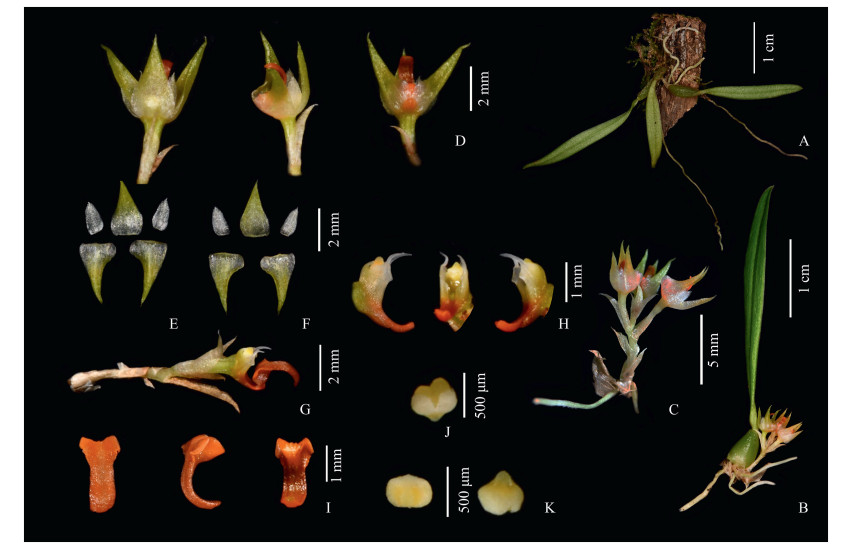
|
| Fig. 7 Bulbophyllum xizangense J.D. Ya & C. Liu, sp. nov. A & B. Plant C. Inflorescence; D. Flower (polar view, lateral view, dorsal view); E. Abaxial sepals and petals; F. Adaxial sepals and petals; G. Column and lip; H. Column lateral view, front view); I. Lip (front view, lateral view, dorsal view); J. Anther cap; K. Pollinarium. (Photographed by J.-D. Ya). |

|
| Fig. 8 Bulbophyllum xizangense J.D. Ya & C. Liu, sp. nov. A & B. Plant; C. Inflorescence; D. Flower (polar view, lateral view, dorsal view); F. Lip (front view, lateral view, dorsal view); G. Lip (flattened); H. Column (lateral view, front view); I. Pollinarium; J. Anther cap. (Drawn by Rong-Mei Zhang). |
Diagnosis: Bulbophyllum xizangense is similar to B. rubrolabellum T.P. Lin and B. tengchongense Z.H. Tsi in floral morphology, but can be distinguished from the former by having narrow lanceolate (vs. oblong) leaves, greenish-yellow (vs. whitish-yellow) flowers, falcate-ovoid (vs. ovate) lateral sepals, a lip with 3 keels (vs. without keels) at the base, and from the latter by having narrow lanceolate leaves (vs. oblong), inflorescence ca. 4.0 mm long and 1–3 flowered (vs. ca. 13 mm long and 4- or 5-flowered), falcate-ovate lateral sepals (vs. ovate-lanceolate), a lip with small lateral lobes and 3 keels at the base (vs. without small lateral lobes and keels).
Type: CHINA. Yunnan: Kunming, voucher from cultivated plants at Kunming Institute of Botany, CAS, 23 Nov. 2018 (flowering), J.-D. Ya & C. Liu 18HT2445 (holotype: KUN!), originally collected in Xizang: Nyingchi City, Mêdog County, 1625 m, subtropical evergreen broadleaved forest edge.
Epiphytic herbs. Rhizome creeping and rooting, ca. 0.8 mm in diam., covered with membranous tubular sheaths. Roots arising from the nodes, 0.5–1.5 mm in diam. Pseudobulbs close to 0.3 cm apart on rhizome, ovoid-conic or ovoid-oblong, ca. 6.0–7.0 × 2.5–4.0 mm, with a sheath that later becomes fibrous and a terminal leaf. Leaf sessile, blade narrowed lanceolate, 20.0–34.0 × 2.5–3.0 mm, leathery, apex acute. Inflorescences arising from the base of pseudobulb, ca. 4.0 mm long, shorter than pseudobulbs; raceme shortened, umbel-like, often 1–3-flowered; peduncle ca. 0.5 mm in diam., 2–4 sterile bracts; floral bract ovoid, membranous, acuminate, concave, ca. 3.5 × 1.5 mm; peduncle and ovary ca. 2.0 mm long. Flowers greenish-yellow, petals white, column foot and lip red. Dorsal sepal ovate, concave, acuminate, ca. 3.2 × 1.8 mm; lateral sepals falcate-ovoid, base adnate to column foot, apex acuminate, ca. 4.0 × 2.0 mm; Petals ovate-lanceolate, ca. 2.1 × 1.0 mm, apex mucronate; lip recurved, lingulate, ca. 1.8 × 1.0 mm, with small lateral lobes at base; disk densely papillate adaxially, base with 3 keels as long as lateral lobes, apex obtuse; column ca. 0.8 mm long, with deltoid, rounded wings, stelidia linear, ca. 0.7 mm long, foot ca. 1.2 mm long, apex attached to lip; anther cap transverse oval, apex mucronate. pollinia 4, isometric, in 2 pairs, ca. 0.5 × 0.2 mm, yellow, ovate, waxy.
Phenology: It was observed in flowering from November to December.
Etymology: The new species is named after its type locality, Xizang, China.
Distribution and habitat: At present, Bulbophyllum xizangense is known from two sites in Mêdog. It grows on the margin of evergreen broadleaved forest at an elevation of 1400–1650 m.
Notes: According to the classification of Genera Orchidacearum both Bulbophyllum ximaense and B. xizangense are placed in sect. Desmosanthes (Bl.) J.J. Smith, which comprises about 76 species distributed from the Himalayas to the Philippines and Sulawesi. This section is characterized by distinct 1-leaved pseudobulbs and creeping rhizomes, solitary inflorescences with 3 to many flowers in a contracted to subumbellate raceme, free sepals, lateral sepals about as long as dorsal sepals or somewhat longer, not twisted inward near base (Chen et al., 2009; Pridgeon et al., 2014).
3.2.3. Bulbophyllum retusum H. Jiang, D.P. Ye & J.D. Ya, sp. nov. (凹萼石豆兰) (Figs. 9 and 10)
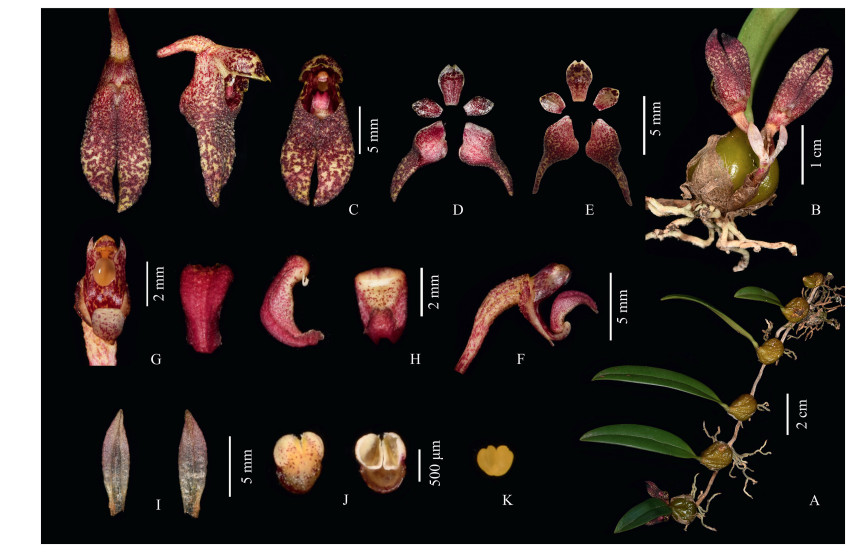
|
| Fig. 9 Bulbophyllum retusum H. Jiang, D.P. Ye & J.D. Ya, sp. nov. A. Plant; B. Inflorescence; C. Flower (dorsal view, lateral view, front view); D. Adaxial sepals and petals; E. Abaxial sepals and petals; F. Column and lip; G. Column; H. Lip (front view, lateral view, dorsal view); I. Bract; J. Anther cap; K. Pollinarium. (Photographed by J.-D. Ya). |
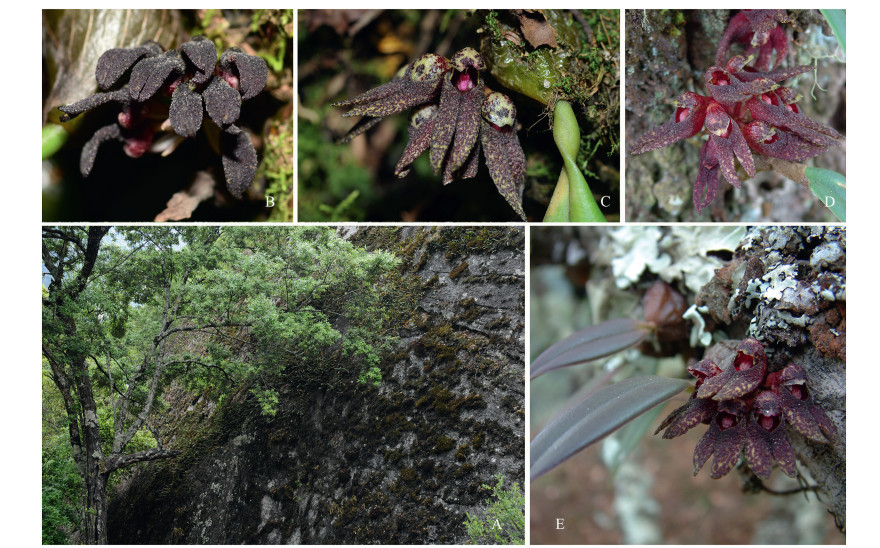
|
| Fig. 10 Bulbophyllum retusum H. Jiang, D.P. Ye & J.D. Ya, sp. nov. with various colours in different areas. A. Habitat in Gongshan; B. Tengchong; C. Malipo; D & E. Zhenyuan. (Photographed by H. Jiang). |
Diagnosis: Bulbophyllum retusum is similar to B. spathulatum (Rolfe ex E.W. Cooper) Seidenf. in floral morphology, but differs by having an inflorescence ca. 1.1 cm long, shorter than the pseudobulb (vs. 3–4 cm long, as long as pseudobulb), peduncles with 2 tubular sheaths (vs. 4 or 5 sheaths), dorsal sepals with a retuse apex (vs. subtruncate and slightly mucronate), lateral sepals with lower edges that are connate to each other and free and divergent toward the apex (vs. upper and lower edges connate to forming a slipper-shaped synsepal), obovate petals with an acute or slightly retuse apex (vs. oblong-lanceolate and apex obtuse).
Type: CHINA. Yunnan: Wenshan Prefecture, Malipo County, Xiajinchang Town, 1550 m, on the trunks of evergreen broadleaved forest on limestone, 8 Oct. 2012, H. Jiang 05599 (holotype: YAF!; isotype: KUN! YAF!)
Epiphytic herbs. Rhizome creeping, ca. 2.0 mm in diam., rooting from base of pseudobulbs, 0.8 mm in diam. Pseudobulbs spaced at 1.0–2.0 cm intervals along the rhizome, finely wrinkled, oblique ovoid or ovoid, ca. 1.4–1.7 × 1.0–1.6 cm, base with two membranous sheaths that later becomes fibrous, apex 1-leaved. Leaf-blade oblong, 2.5–15.0 × 0.8–2.0 cm, leathery, apex acute, base narrowing into a short petiole; petiole 3.0–5.0 mm long. Inflorescence arising from base of terminal pseudobulb, ca. 1.1 cm long, shorter than pseudobulbs; raceme shortened, umbel-like, often 2–10-flowered; peduncle ca. 1.5 mm in diam., covered with two papery tubular sheaths; floral bract obovate, obtuse, concave, ca. 7.5 × 4.5 mm, externally verrucose; peduncle and ovary ca. 1.0–1.5 cm long, verrucose. Flowers yellowish green with dark red to dark purple blotched, lip dark red or dark purple-red adaxially and yellowish-green with dark red or dark purple-red blotched abaxially. Dorsal sepal obovate, concave, apex retuse, ca. 7.8 × 4.5 mm; lateral sepals oblique oblong-lanceolate, ca. 2.5 × 0.6 mm, base adnate to column foot form a short and 2-lobed mentum, lower edges connate to each other, free and divergent toward apex, apical ca 1/2 length of margins incurved and tubular, apex horn-shaped, obtuse, externally verrucose; petals obovate, ca. 3.5 × 4.8 mm, apex acute or slightly retuse; lip deflexed, lingulate, ca. 4.5 × 2.5 mm, base hinged to the apex of the column foot, apical margin thicken forming two longitudinal keels; column and foot pale yellow with dark red blotched, column ca. 3.2 mm long, stelidia deltoid, ca. 1.0 mm long, foot incurved, ca. 2.8 mm long, with free portion ca. 1.2 mm long; anther cap ovoid, ca. 0.75 × 0.85 mm. Pollinia 4, in 2 pairs, ca. 0.5 mm long, yellow, ovate, waxy.
Phenology: It was observed in flowering from October to November.
Etymology: The specific epithet "retusum", meaning "having a rounded apex with a shallow notch", refers to the retuse dorsal sepal of this new species.
Distribution and habitat: In Yunnan, it is known from the southeast, south-central and northwest part of the province, while in Xizang it has been recorded only from Chawalong Town, near the border with Yunnan. It is epiphytic on trees or lithophytic on rocks in monsoon evergreen broadleaved forest and mixed broadleaf-conifer forest at an elevation of 1400–2100 m.
Additional specimens examined (paratypes): CHINA. Yunnan: Pu'er City, Zhenyuan County, Enle Town, 2050 m, Quercus trunks in mixed coniferous and broadleaved forest, 3 Nov. 2006, H. Jiang 04407 (YAF!); Nujiang Prefecture, Gongshan County, Bingzhongluo Town, 1610 m, on tree trunks in monsoon evergreen broadleaved forest, 27 Apr. 2013, H. Jiang 05664 (YAF!); Baoshan City, Tengchong County, Houqiao Town, 1680 m, on tree trunks of monsoon evergreen broadleaved forest, 21 Oct. 2019, H. Jiang 09005 (YAF!); Chuxiong Prefecture, Chuxiong County, Lucheng Town, 1915 m, on Quercus trunks in a river valley, 8 Dec. 2019, J.-D. Ya, L. Huang, R.-Z. Zhang 19HT3315 (KUN!). Xizang: Nyingchi City, Zayü County, Chawalong Town, 1740 m, on rocks in evergreen broadleaved forest in a river valley, 25 Apr. 2013, H. Jiang 05638 (YAF!).
Notes: This species was firstly named Bulbophyllum breviscapum H. Jiang & D.P. Ye in The Wild Orchid in Yunnan (Xu et al., 2010). However, according to Art. 40.1 of International Code of Nomenclature for algae, fungi and plants (Shenzhen Code) (Turland et al., 2018), this name was not validly published because the authors failed to provide a diagnosis or description or designate the type, and it is not available for use because of a species previously named B. breviscapum (Rolfe) Ridl. (Ridley, 1907).
According to Genera Orchidacearum, Bulbophyllum retusum belongs to sect. Brachyantha Rchb. f., which is characterized by having a distinct creeping rhizome, 1-leaved pseudobulbs, inflorescences with two to many flowers, a subumbellate raceme, free dorsal sepals, lateral sepals usually 2–6 times as long as dorsal sepals and usually twisted inward near base, glabrous margins, with the upper margins approaching or meeting and connate, lip margins without auricles or lateral lobes. There are about 26 species in this section distributed from India to Japan; species are also found in the Philippines and New Guinea (Chen et al., 2009; Pridgeon et al., 2014).
3.2.4. Bulbophyllum frostii Summerh., Bull. Misc. Inform. Kew 76.1928; Seidenf., Opera bot. 144: 280, 1992; H.H. Pham, Ill. Fl. Vietnam 3: 852, 2000.≡ Cirrhopetalum frostii (Summerh.) Garay, Hamer & Siegerist, Nordic J. Bot. 14: 621.1994. Type: Vietnam. 28 Nov. 1927, M. Sandes s.n. (K barcode K000891074!). Cirrhopetalum bootanoides Guillaumin, Bull. Mus. Natl. Hist. Nat., sér. 2, 28: 548.1957. ≡ Bulbophyllum bootanoides (Guillaumin) Seidenf., Dansk Bbt. Ark. 29: 60, 1974 [1973]. Type: Vietnam, Annam, Dalat. 15 May 1955, C.R.S.T., 203sig (P barcode P00348032!) (缘毛卷瓣兰) (Fig. 11).

|
| Fig. 11 Bulbophyllum frostii Summerh. A. Plant; B. Inflorescence; C. Flower; D. Column and lip; E. Petal; F. Dorsal sepal; G. Lateral sepals; H. Lip (lateral view); I. Lip (dorsal view); J. Column; K. Anther cap; L. Pollinarium. (Photographed by Q. Liu). |
Epiphytic herbs. Pseudobulbs ca. 1.3 cm apart on rhizome, oblique-ovoid, ca. 1.5–2.0 × 1.5–2.0 cm, base with two papery sheaths, apex 1-leaved. Leaf blade oval to oblong, sessile, 3.0–5.0 × 1.2–2.0 cm, fleshy, apex obtuse. Inflorescence arising from base of terminal pseudobulb, ca. 1.5–2.0 cm long; raceme shortened, umbel-like, often 1–3-flowered; peduncle ca. 1.5 mm in diam., 2–4 sterile bracts; floral bract lanceolate, acuminate, concave, ca. 0.8 cm long; peduncle and ovary ca. 1.0 cm long. Flowers yellowish-green blotched with dark red, lip dark red. Dorsal sepal orbicular-ovate, concave, ca. 13.0 × 9.0 mm, apex shortly acuminate, mucronate, abaxially tomentose and verrucose, margin ciliate; lateral sepals oblique oblong-lanceolate, ca. 20.0 × 8.0–9.0 mm, 7-veins, base adnate to column foot, twisted near base, connate along upper margin, apex acuminate, abaxially tomentose and verrucose, margin entire; Petals oblong, concave, ca. 10.0 × 6.0 mm, apex obtuse, margin ciliate; lip fleshy and thickened, deflexed, sagittate in outline, ca. 7.0–8.0 × 5.0 mm, base auricular and lobes tomentose, disk with 2 keels and irregularity, apical acuminate, column pale yellow with dark red blotched, ca. 5.0 mm long, with entire wings at middle, stelidia minute, foot incurved, ca. 8.0 mm long, with free part ca. 3.5 mm long; anther cap ovoid. Pollinia 4, in 2 pairs, yellow, ellipsoid with the significant viscidium.
Phenology: It was observed in flowering from July to August.
Distribution and habitat: Bulbophyllum frostii is distributed in China (Yunnan) and Vietnam (Khanh Hoa, Dalat, Gia Lai, Kontum). This is the first record of B. frostii from China, where it occurs in Malipo County, Wenshan Prefecture, Yunnan Province. The species is epiphytic on tree trunks in limestone forest at elevations of 1800–2000 m.
Specimens examined: CHINA. Yunnan: Wenshan Prefecture, Malipo County, Xiajinchang Town, 1950 m, on the tree trunks in limestone forest, 24 July 2017, Q. Liu 465 (HITBC).
According to Genera Orchidacearum, Bulbophyllum frostii belongs to sect. Cirrhopetaloides Garay, Hamer & Siegerist. The section is characterized by having a distinct creeping rhizome, 1-leaved pseudobulb, subumbellate raceme, free dorsal sepals, entire erose or fimbriate margins, lateral sepals distinctly longer than dorsal sepals and twisted inward near base, with free or adnate upper margins, denticulate and fimbriate petal margins, and an entire lip. Sect. Cirrhopetaloides comprises about 19 species distributed from India to Malaysia, the Philippines and Japan (Pridgeon et al., 2014).
3.2.5. Bulbophyllum raskotii J.J. Verm., Schuit. & de Vogel, Phytotaxa 166: 105.2014≡ Sunipia nepalensis raskoti & Ale, Phytotaxa 31: 55.2011, not Bulbophyllum nepalense raskoti & Ale, nom. Illeg. Type: Nepal. Makawanpur Distric, Daman, Simbhanjyang, 2400 m, May 2008, B.B. raskoti 270 (holotype KATH, isotype TUCH). (滇西大苞兰) (Fig. 12).

|
| Fig. 12 Bulbophyllum raskotii J.J. Verm., Schuit. & de Vogel A. Plant; B. Leaf; C. Inflorescence; D. Flower (lateral view); E. Flower (front view); F. Adaxial sepals and petals; G. Abaxial sepals and petals; H. Column and lip; I. Lip; J. Column (lateral view, front view); K. Anther cap; L. Pollinarium. (Photographed by J.-D. Ya). |
Epiphytic herbs. Rhizome creeping, ca. 2.0 mm in diam., rooting from base of pseudobulbs, 0.6–1.0 mm in diam. Pseudobulbs 3.3–4.5 cm apart along the rhizome, ovoid, ca. 1.3–1.5 × 0.8–1.2 cm, base with one membranous sheath that later becomes fibrous, apex 1-leaved. Leaf blade oblong to oblong-lanceolate, 4.0–6.8 × 1.2–1.5 cm, leathery, apex subacute, obscurely bilobed, base narrowing into a short petiole; petiole 4.0–8.0 mm long. Inflorescence arising from base of pseudobulb, ca. 6.0–8.0 cm long, 2–4-flowered; peduncle ca. 0.8 mm in diam., covered with one papery tubular sheaths; floral bract lanceolate, apices obtuse, concave, ca. 4.0–7.0 × 2.4–2.8 mm; peduncle and ovary ca. 1.5–2.5 cm long. Flowers widely opening, sepals yellowish green and margin dark purple, petals yellowish green, lip dark purple and basal margin yellowish green, veins dark purple. Dorsal sepal, ovate-lanceolate, ca. 8.0 × 3.0 mm, margin entire, glabrous, 5-veined, apex acuminate; lateral sepals free, similar with dorsal sepal, ca. 10.0 × 4.0 mm; petals suborbicular, ca. 3.0 × 3.0 mm, margin entire, glabrous, 1-veined, apex obtuse; lip ovate-lanceolate, abruptly contracted near basal 1/3 length, ca. 7.0 × 4.0 mm, 3-veined, basally with a transverse callus, apex obtuse; column yellowish-green, ca. 2.0 mm long, foot 0.6 mm long; anther cap transverse ovoid, ca. 0.8 × 1.3 mm. Pollinia 4, in 2 pairs, transverse reniform, apex retuse, ca. 0.4 × 0.5 mm, yellow, waxy, each pair of pollinia with a stipe and a viscidium.
Phenology: It was observed in flowering from June to July.
Distribution: The species is found in China (Yunnan) and Nepal (Makawanpur District). It is newly recorded from China, occurring in Dali (Yunlong) and Nujiang (Lushui), Yunnan Province.
Specimens examined: CHINA. Yunnan: Dali Prefecture, Yunlong County, Minjian Town, 2015 m, evergreen broadleaved forest edge, 1 Jun. 2020, J.-D. Ya, Z.-D. Han & C.-H. Li, 20HT3479 (KUN); Nujiang Prefecture, Lushui County, Laowo Town, 2610 m, on Quercus trunks at summit of mossy dwarf forest, 9 Jun. 2016, H. Jiang & W.-P. Zhang, 06683 (KUN, YAF).
3.2.6. Bulbophyllum pulcherissimum H. Jiang, D.M. He & J.D. Ya, sp. nov. (美花大苞兰) (Figs. 13 and 14)
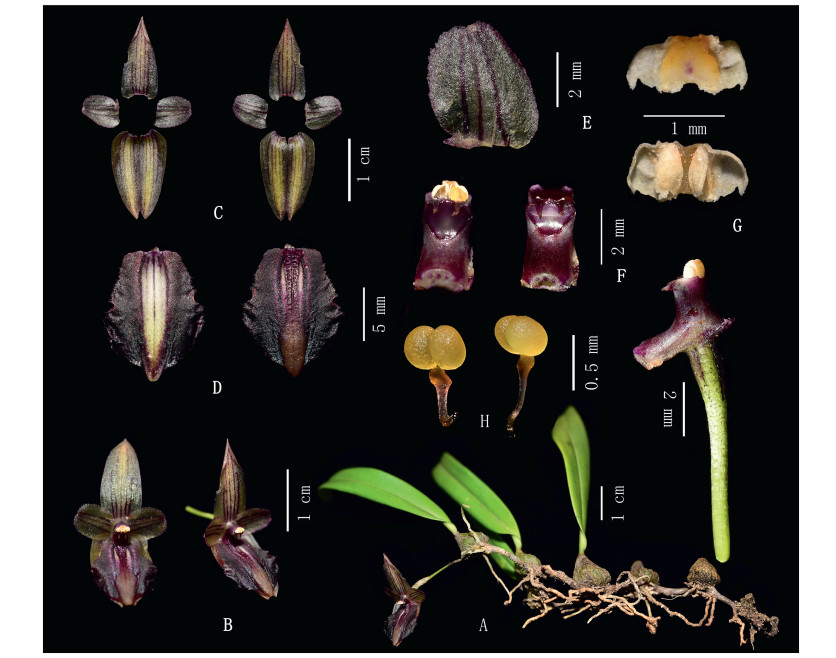
|
| Fig. 13 Bulbophyllum pulcherissimum H. Jiang, D.M. He & J.D. Ya, sp. nov. A. Plant; B. Flowers (front view, lateral view); C. Sepals and petals (adaxial view, abaxial view); D. Lip (abaxial view, adaxial view); E. Petal; F. Column; G. Anther cap; H. Pollinarium. (Photographed by H. Jiang). |
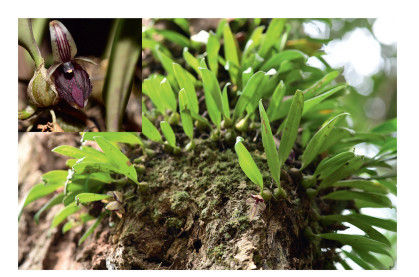
|
| Fig. 14 Habitat of Bulbophyllum pulcherissimum H. Jiang, D.M. He & J.D. Ya, sp. nov. (Photographed by H. Jiang). |
Diagnosis: Bulbophyllum pulcherissimum is similar to B. lopalanthum J.J. Verm., Schuit. & de Vogel. in floral morphology, but can be distinguished by its 5-veined (vs. 7-veined) dorsal sepal, ovate-lanceolate (vs. oblong) lateral sepals, obliquely ovate-oblong petals, erose-toothed margins (vs. subulate, margin fimbriate) and obovate lip with a large, oblong basal callus, and an obtuse base (vs. broad cordate-ovate, center greatly thickened and fleshy, base retuse).
Type: CHINA. Yunnan: Wenshan Prefecture, Wenshan County, Gumu Town, 1760 m, on tree trunks in monsoon evergreen broadleaved forest, 17 Mar. 2020, H. Jiang 10026 (holotype: YAF!; isotype: KUN!).
Epiphytic herbs. Rhizome creeping and rooting, 1.2–1.5 mm in diam. Pseudobulbs often 1.0–1.5 cm apart on rhizome, ovoid-conic, ca. 0.7–1.0 × 0.6–0.8 cm, with a terminal leaf. Leaf-blade narrowly oblong, 3.5–5.8 × 0.6–0.9 cm, leathery, apex obtuse and retuse, base narrowing into a short petiole; petiole 2.0–2.5 mm long. Scape arising from the base of pseudobulb, peduncle slender, 1.3–1.5 cm long, with 3 sheaths ca. 8 mm; raceme 1 (2)-flowered; floral bract ovate, 5.0–5.5 × 2.5–3.0 mm, apex shortly acuminate; peduncle and ovary ca. 0.8–0.9 cm long. Flowers pale yellowish-green, veins purple-red; lip dark purple or purple-red, abaxially ridge yellowish-green; column dark purple. Dorsal sepal oblong-ovate, ca. 1.2–1.3 × 0.5–0.6 cm, margin entire, glabrous, 5-veined, apex acuminate; lateral sepals ovate-lanceolate, 1.3–1.4 × 0.4–0.5 cm, glabrous, 5-veined, lower edges connate to each other with free apices, apex acuminate. Petals obliquely ovate-oblong, ca. 5.5 × 4.5 mm, 3-veined, margins erose-toothed, apex obtuse-rounded or retuse; lip obovate, 1.2–1.3 × 0.8–0.9 cm, margin erose, apex acuminate, adaxially with 1 thickened ridge from base to apex, ridge base forming a large oblong callus with swollen apex; column ca. 1.5 × 2.0 mm, foot ca. 2.3–2.5 mm long, stelidia dentiform, acuminate; anther cap transverse oblong. Pollinia 4, in 2 pairs, yellow, ovate, waxy, each pair of pollinia with a stipe and a viscidium.
Phenology: It was observed in flowering from October to March.
Etymology: The specific epithet "pulcherissimum", meaning "very pretty", refers to the large and elegant flowers in sect. Ione (Lindl.) J.J. Verm., Schuit. & de Vogel, the width of lip up to 0.9 cm.
Distribution and habitat: Bulbophyllum pulcherissimum is currently known from central and southeast Yunnan. It is a predominantly epiphytic species that grows on tree trunks in monsoon evergreen broadleaved forest at elevations of 1760–2050 m.
Additional specimen examined (paratypes): CHINA. Yunnan: Yuxi City, Xinping County, Jianxin Town, 2050 m, on tree trunks in evergreen broad-leaved forest, 20 Oct. 2020, H. Jiang 10122 (YAF).
Note: According to Genera Orchidacearum, both Bulbophyllum pulcherissimum and B. raskotii belong to sect. Ione (Lindl.) J.J. Verm., Schuit. & de Vogel , which is characterized by lateral sepals usually connate at the base along the lower margins just below lip, very short or inconspicuous column-foot, a lip that is not mobile, pollinia in 2 pairs, with a common Y-shaped stipe and a single viscidium, or each pair with a stipe and a viscidium. Ione consists of about 20 species distributed from China to Nepal, Myanmar, Thailand, and Vietnam (Chen et al. 2009; Pridgeon et al., 2014).
3.2.7. Bulbophyllum nematocaulon Ridl., J. Straits Branch Roy. Asiat. Soc. 82: 197.1920Type: Malaysia, 16 Aug. 1888, Scortechini B. 614 (holotype: K barcode K000829265!)– Bulbophyllum oreas Ridl., Fl. Malay Penins. 4: 63.1924. Type: Malaysia, Gunong Tahan. 12 Jun. 1922, Haniff M. 7894 (K barcode K000829264!). Bulbophyllum johannis-winkleri J.J. Sm., Mitt. Inst. Allg. Bot. Hamburg 7: 59.1927. (绿花石豆兰) (Fig. 15, Fig. 16
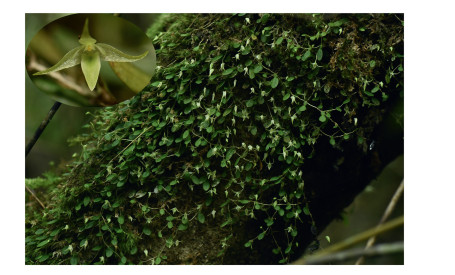
|
| Fig. 15 Bulbophyllum nematocaulon Ridl. Plants in natural habitat. (Photographed by X.-H. Jin & H. Jiang). |

|
| Fig. 16 Bulbophyllum nematocaulon Ridl. A. Plant; B. Flower; C. Dorsal sepal; D. Petal; E. Lateral sepal; F. Lip (adaxial view); G. Lip (abaxial view); H. Column with lip (lateral view). (Drawn by Ai-li Li). |
Epiphytic herbs. Rhizome creeping, ca. 0.5 mm diam., sections between pseudobulbs 0.5 (0.2) −1.0 cm long; rhizome scales persistent, 1–2 mm long; roots spreading from base of pseudobulbs. Pseudobulbs distinct, erect, ovoid to oblong, greenish, 2.0–3.5 × 1.5–2.0 mm, not angular, with a terminal leaf. Leaf one; petiole ca.0.5 mm long, twisted; leaf blade elliptic to oblong, 5.0–9.0 × 2.0–3.0 mm, leathery, apex acute, mucronate. Scape from base of pseudobulb, erect, 4.0–10.0 mm long, 1-flowered, scales 2–3; floral bracts cupular, ca. 1.0 mm long. Flowers yellowish-white, ovary with pedicel ca. 1.5 mm long. Median sepal slightly recurved, ovate-lanceolate, 4.0–5.0 × 1.5–2.0 mm, margins entire, glabrous, 3-veined, long acuminate with an obtuse apex. Lateral sepals free, oblique, recurved, ovate-triangular, 4.0–5.0 × 1.5–2.5 mm, margin entire, glabrous, 3-veined, long acuminate with an obtuse apex. Petals elliptic, 2.0–2.5 × 0.5–1.0 mm, margin entire, glabrous, 1-veined, acute apex. Lip yellowish-green, recurved, ovate-oblong with slightly narrow base, 2.5–3.0 × ca. 1.2 mm, margins entire near the base, papillose-lacerate along lower middle half, and papillose-pubescent elsewhere, 3-veined, apex obtuse, adaxially concave from base to middle with a depression formed by the median line, adaxial and abaxial surfaces glabrous near base, papillose-pubescent elsewhere. Column ca. 1.5 mm long; stelidia porrect, oblong, bifid at apex, ca. 0.5 mm long, tooth obtuse; column wings distinct along lower margin; column foot ca. 1.0 mm long, not widened at apex; pollinia 2.
Phenology: It was observed in flowering from May to June.
Distribution: Bulbophyllum nematocaulon is distributed in China, Peninsular Malaysia, Indonesia (Kalimantan) and N. Vietnam. It is recorded from China for the first time, occurring in Malipo, Yunnan Province. The species is epiphytic on tree trunks in moist forest at elevations between 1000 and 1200 m.
Specimens examined: CHINA. Yunnan: Wenshan Prefecture, Malipo County, Tianbao Town, 1125 m, 16 May 2020, X.H. Jin 31025 (PE); Wenshan Prefecture, Malipo County, Tianbao Town, Bajiaoping Village, 1140 m, 23 May 2020, H. Jiang 10216 (YAF).
Notes: According to Genera Orchidacearum, Bulbophyllum nematocaulon belongs to sect. Monanthaparva Ridley. This section is characterized by having small plants, distinct 1-leaved pseudobulbs and creeping rhizomes, 1-flowered inflorescences with the basal node of pedicel well above the floral bract attachment, and lips with papillose-ciliate margins. Sect. Monanthaparva consists of about 38 species distributed from China to Vietnam, Thailand, Indonesia and the Philippines (Chen et al. 2009; Pridgeon et al., 2014).
4. DiscussionWe evaluated the conservation status of these new species according to the IUCN Red List Categories and Criteria (IUCN 2017). Five species, Cheirostylis chuxiongensis, C. yei, Myrmechis lingulata, M. longii, Bulbophyllum ximaense and B. xizangense, are only known from type localities and adjacent areas. For each of these species, our field surveys identified only one or two populations with few individuals. The conservation status of these species is therefore considered to be Data Deficient (DD).B. retusum, which is widely distributed in Yunnan and Xizang, has no obvious threats; hence, the new species is tentatively considered to be Least Concern (LC). Although B. nematocaulon is only known from two populations of over 1000 individuals that grow on the trunks of trees near the border of China and Vietnam, the habitat is unlikely to be subject to significant human activities due to the restricted access to the border area; the new species is therefore assigned a preliminary status of Least Concern (LC). B. raskotii is known from two sites with more than 10, 000 individuals scattered in a protected evergreen broadleaved forest and mossy dwarf forest in the west of Yunnan. Its conservation status is suggested as Least Concern (LC) based upon the population size and healthy habitat. Two big populations of B. pulcherissimum (> 1000 individual plants) were found in central and southeast Yunnan. However, our field investigations indicate that this species is regularly collected by locals because of its great ornamental value; therefore, we suggest that the current conservation status of this new species is Near Threatened (NT).
These new taxa and records are mainly distributed in southeast Xizang, the Hengduan Mountains and southeast Yunnan, which are regarded as hotspots of orchid diversity as well as hotspots for China's endemic flora in general (Zhang et al., 2015; Huang et al., 2016). The majority of our knowledge of orchids from these regions is accumulated from floras (Chen et al., 2009; Xu et al., 2010; Jin et al., 2019), ongoing regional surveys (Jin et al., 2018; Wang et al., 2018) and descriptions of new species (Hu et al., 2013; Averyanov et al., 2015, 2019; Liu et al., 2016a; Zhai et al., 2017; Zhang et al., 2017; Cai et al., 2019; Li et al., 2019; Ya et al., 2019a, b; Aung et al., 2020; Du et al., 2020; Yang et al., 2020). The geographic distributions of many species remain unknown, and the potential discovery of undescribed orchid species, especially in the shrinking primeval forests of the region, requires continued field work. The knowledge of the orchids of China and adjacent regions can be increased by investment in surveys and research at more localities using different approaches.
Author contributionsJ-DY, JC and HJ conceived the study, wrote and revised the manuscript. J-DY, TZ, HJ, CL, Z-DH, D-PY, D-MH, QL, LY, LH, R-ZZ contributed to field surveys, J-DY, HJ and T-RP provided the species description. All the authors approved the final version.
Declaration of competing interestThere is no conflict of interest.
AcknowledgmentsWe are grateful to Xiao-hua Jin for their valuable discussions and suggestions, Lian-Yi Li for his help with image processing, Qiao-Rong Zhang, and Chang-Hong Li, for their kind assistance in the field. Ai-li Li is thanked for her outstanding illustrations. We convey our special thanks to the Forestry and Grassland Bureau of Linzhi Prefecture, Forestry and Grassland Bureau of Dehong Prefecture for their kind help in the field. This study was financially supported by National Forestry and Grassland Administration (2019073017, 2019073019), National Science & Technology Infrastructure, the Large-scale Scientific Facilities of the Chinese Academy of Sciences (2017-LSFGBOWS-02), grants from the National Natural Science Foundation of China (Nos. 41672018, 31670194, 31870195) and the Southeast Asia Biodiversity Research Institute, Chinese Academy of Sciences (No. Y4ZK111B01), National Wild Plant Germplasm Resource Center for Yunnan Academy of Forestry and Grassland (ZWGX2003).
Aung, Y.L., Mu, A.T., Aung, M.H., et al, 2020. An annotated checklist of Myanmar orchid flora. PhytoKeys, 138: 49-112. DOI:10.3897/phytokeys.138.36144 |
Averyanov, L.V., Duy, N.V., Tuan, N.H., et al, 2018. New species of Bulbophyllum (Orchidaceae) in the flora of Vietnam. Phytotaxa, 369: 1-14. DOI:10.11646/phytotaxa.369.1.1 |
Averyanov, L.V., Nguyen, K.S., Nguyen, T.T., et al, 2015. New orchids in the flora of Vietnam. Wulfenia, 22: 137-188. |
Averyanov, L.V., Nguyen, K.S., Maisak, T.V., et al, 2019. New orchid species (Orchidaceae) in the flora of Laos. Новости систематики высших растений, 50: 25-40. DOI:10.31111/novitates/2019.50.25 |
Cai, J., Yu, W.B., Zhang, T., et al, 2019. China's biodiversity hotspots revisited: a treasure chest for plants. PhytoKeys, 130: 1-24. DOI:10.3897/phytokeys.130.38417 |
Cameron, Y.T., Hills, H.G., Goldman, D.H., 1999. A phylogenetic analysis of the Orchidaceae: evidence from rbcL nucleotide sequences. Am. J. Bot., 86: 208-224. DOI:10.2307/2656938 |
Chase, M.W., Cameron, K.M., Freudenstein, J.V., et al, 2015. An updated classification of Orchidaceae. Bot. J. Linn. Soc., 177: 151-174. DOI:10.1111/boj.12234 |
Chen, S.C., Liu, Z.J., Zhu, G.H., et al., 2009. Orchidaceae. In: Wu, Z.Y., Raven, P.H., Hong, D.Y. (Eds.), Flora of China, vol. 25. Science Press, Beijing, & Missouri Botanical Garden Press, Saint Louis, pp. 1-506.
|
Chen, S.P., Tian, H.Z., Guan, Q.X., et al, 2019. Molecular systematics of Goodyerinae (Cranichideae, Orchidoideae, Orchidaceae) based on multiple nuclear and plastid regions. Mol. Phylogenet. Evol., 139: 106542. DOI:10.1016/j.ympev.2019.106542 |
Du, C., Liao, S., Boufford, D.E., et al, 2020. Twenty years of Chinese vascular plant novelties, 2000 through 2019. Plant Divers., 42: 393-398. DOI:10.1016/j.pld.2020.08.004 |
Hemsley, W.B., 1895. Descriptions of some new plants from East Asia. Ann. Bot., 9: 158. |
Hu, G.W., Long, C.L., Motley, T.J., 2013. Cremastra malipoensis (Orchidaceae), a new species from Yunnan, China. Syst. Bot., 38: 64-68. DOI:10.1600/036364413X662033 |
Huang, J.H., Liu, C.R., Zhang, J.L., et al, 2016. Diversity hotspots and conservation gaps for the Chinese endemic seed flora. Biol. Conserv., 198: 104-112. DOI:10.1016/j.biocon.2016.04.007 |
IUCN, 2017. Guidelines for Using the IUCN Red List Categories and Criteria. Version
13. IUCN, Gland, Switzerland, and Cambridge, United Kingdom.
|
Jin, X.H., Li, H., Li, D.Z., 2007. Additional notes on orchidaceae from Yunnan, China. Acta Phytotaxon. Sin., 45: 796-807. DOI:10.1360/aps06216 |
Jin, X.H., Li, H., Li, D.Z., 2007. Four newly recorded species of Orchidaceae from Yunnan, China. Acta Phytotaxon. Sin., 29: 393-394. DOI:10.1360/aps06216 |
Jin, X.H., Li, J.W., Ye, D.P., 2019. Atlas of Native Orchids in China. Henan Science and
Technology Press, Zhengzhou.
|
Jin, X.H., Tan, Y.H., Quan, R.C., 2018. Taxonomic discoveries bridging the gap between our knowledge and biodiversity. In: Jin, X.H., Shui, Y.M., Tan, Y.H.,
Kang, M. (Eds.), Plant Diversity in Southeast Asia. PhytoKeys, vol. 94, pp. 1-2.
https://doi.org/10.3897/phytokeys.94.23887.
|
Li, J.W., Wang, X.L., Wang, C.W., et al, 2019. Bulbophyllum yarlungzangboense (Orchidaceae; Epidendroideae; Malaxideae), a new species from Tibet, China. Phytotaxa, 404: 79-84. DOI:10.11646/phytotaxa.404.2.3 |
Lin, T.P., 1975. New additions to the orchid flora of Taiwan. Taiwania, 20: 162-164. |
Liu, Q., Tan, Y.H., Gao, J.Y., 2016. A new species of Gastrochilus (Aeridinae, Vandeae, Orchidaceae) and a new record species from Yunnan, China. Phytotaxa, 282: 66-70. DOI:10.11646/phytotaxa.282.1.8 |
Liu, Q., Zhou, S.S., Li, R., et al, 2017. Bulbophyllum putaoensis (Orchidaceae; Epidendroideae; Malaxideae), a new species from Kachin state, Myanmar. Phytotaxa, 305: 57-60. DOI:10.11646/phytotaxa.305.1.9 |
Liu, Z.L., Liu, Q., Gao, J.Y., 2016. Cheirostylis acuminata (Orchidaceae; Cranichideae; Goodyerinae): a new species from yunnan province, China. Phytotaxa, 247: 138-142. DOI:10.11646/phytotaxa.247.2.6 |
Ma, L., Zhang, S., Zhou, Z., et al, 2020. Bulbophyllum linzhiense (Orchidaceae, Malaxideae), a new species from China. Phytotaxa, 429: 281-288. DOI:10.11646/phytotaxa.429.4.4 |
Maity, D., Pradhan, N., Maity, G.G., 2007. Myrmechis bakhimensis D. Maity, N. Pradhan & G. G. Maiti, a new species of Orchidaceae from Sikkim Himalaya. Acta Phytotaxon. Sin., 45: 321-323. DOI:10.1360/aps050143 |
Pedersen, H. Æ., Kurzwell, H., Suddee, S., et al., 2011. Cheirostylis. In: Santisuk, T.,
Balslev, H. (Eds.), Flora of Thailand, vol. 12. The Forest Herbarium, Department
of National Park, Wildlife and Plant Conservation, Bangkok, pp. 29-42, 1.
|
POWO, 2021. Plants of the world online. Facilitated by the royal botanic gardens,
kew. Published on the Internet. http://www.plantsoftheworldonline.org/.
(Accessed 21 January 2021).
|
Pridgeon, A.M., Cribb, P.J., Chase, M.W., et al., 2003. Goodyerinae. Genera Orchidacearum, Volume 3, Orchidoideae (Part Two) Vanilloideae. Oxford University
Press, Oxford, pp. 63-152.
|
Pridgeon, A.M., Cribb, P.J., Chase, M.W., et al., 2014. Bulbophyllum. In: Genera Orchidacearum, vol. 6. Epidendroideae (part three). Oxford University Press, Oxford, pp. 3-51.
|
Raskoti, B.B., Ale, R., 2011. A new species of Sunipia (Orchidaceae) from Nepal. Phytotaxa, 31: 55-58. DOI:10.11646/phytotaxa.31.1.2 |
Ridley, H.N., 1907. Materials for a Flora of the Malayan Peninsula, vol. 1. Methodist
Publishing House, Singapore, p. 78.
|
Rolfe, R.A., 1896. New orchids. Bull. Misc. Inform. Kew, 1896(119): 201. |
Rolfe, R.A., 1903. An enumeration of all plants known from China proper, Formosa, Hainan, Corea, the Luchu archipelago, and the Island of Hongkong, together with their distribution and synonymy. J. Linn. Soc., Bot., 3: 44. |
Schuiteman, A., 2011. Dendrobium (Orchidaceae): to split or not to split?. Gard. Bull. Singapore, 63: 245-257. |
Seidenfaden, G., 1969. Notes on the genus Ione. Bot. Tidsskr., 64: 205-238. |
Seidenfaden, G., 1978. Orchid genera in Thailand VI. Neottioideae Lindl. Dansk Bot. Arkiv., 32: 61-77. |
Seidenfaden, G., 1979. Orchid genera in Thailand VIII. Bulbophyllum thou. Dan. Bot. Ark., 33: 1-228. |
Summerhayes, V.S., 1928. Decades Kewenses. Plantarum novarum in herbario horti regii conservatarum. Decas CXIX. Bull. Misc. Inform. Kew, 1928(2): 72-78. |
Tsi, Z.H., 1989. New taxa of Orchidaceae from China. Bull. Bot. Res., Harbin., 9: 21-31. |
Turland, N.J., Wiersema, J.H., Barrie, F.R., et al., 2018. International Code of
Nomenclature for Algae, Fungi, and Plants (Shenzhen Code) Adopted by the
Nineteenth International Botanical Congress Shenzhen. Regnum Vegetabile159:
[i]-xxxviii, China, pp. 1e253. https://doi.org/10.12705/Code.2018 [electronic
version available on 27 June 2018].
|
Vermeulen, J.J., O'Byrne, P., Lamb, A., 2015. Bulbophyllum of Borneo. Natural History Publications (Borneo), Sdn. Bhd., Kota Kinabalu, p. 728.
|
Vermeulen, J.J., Schuiteman, A., de Vogel, E.F., 2014. Nomenclatural changes in Bulbophyllum (Orchidaceae; Epidendroideae). Phytotaxa, 166: 101-103. DOI:10.11646/phytotaxa.166.2.1 |
Wang, X.L., Li, J.W., Wang, C.W., et al, 2018. New information of orchids in Tibet, China. Guihaia, 38: 1440-1445. DOI:10.23919/icems.2018.8549010 |
Wu, X.F., Liu, Q., Li, J.L., et al, 2020. Cheirostylis barbata, a new species Orchidaceae (Goodyerinae) from yunnan, China. Phytotaxa, 436: 293-297. DOI:10.11646/phytotaxa.436.3.7 |
Xu, Z.H., Jiang, H., Ye, D.P., et al., 2010. The Wild Orchids in Yunnan. Yunnan
Publishing Group Corporation & Yunnan Science and Technology Press,
Kunming.
|
Ya, J.D., Guo, Y.J., Liu, C., et al, 2019. Bulbophyllum reflexipetalum (Orchidaceae; Epidendroideae; Malaxideae), a new species from Xizang, China. PhytoKeys, 130: 33-39. DOI:10.3897/phytokeys.130.34153 |
Ya, J.D., Jin, X.H., Liu, C., 2019. Two new species of Cylindrolobus (Orchidaceae) from the eastern Himalayas. PhytoKeys, 130: 107-113. DOI:10.3897/phytokeys.130.33989 |
Yang, B., Deng, M., Zhang, M.X., et al, 2020. Contributions to the flora of Myanmar from 2000 to 2019. Plant Divers., 42: 292-301. DOI:10.1016/j.pld.2020.06.005 |
Yukawa, T., 2016. Taxonomic notes on the Orchidaceae of Japan and adjacent regions. Bull. Natl. Sci. Mus. B, 42: 103-111. |
Zhang, W.L., Gao, J.Y., Pan, B., et al, 2017. Habenaria malipoensis (Orchidaceae: Orchidoideae: Orchidinae), a new orchid species from Yunnan, China. Phytotaxa, 332: 93-97. DOI:10.11646/phytotaxa.332.1.11 |
Zhang, Y.B., Du, H.D., Jin, X.H., et al, 2015. Species diversity and geographic distribution of wild Orchidaceae in China (in Chinese). Chin. Sci. Bull., 60: 179-188. DOI:10.1360/N972014-00480 |
Zhai, J.W., Chen, X.P., Chen, Y.Q., et al, 2017. Bulbophyllum yingjiangense, a new species from Yunnan, China: morphological and molecular evidence (Orchidaceae; Epidendroideae). Phytotaxa, 298: 77-82. DOI:10.11646/phytotaxa.298.1.8 |




